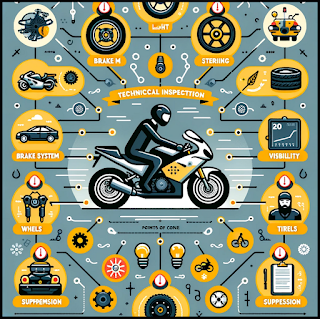 The Technical Control of the Two-Roues in France
The Technical Control of the Two-Roues in France
The technical control of the two-wheels, three-wheel drive and four-wheel drive is an important measure of road safety in France. This obligation is intended to ensure that vehicles of these categories are in good working condition, thereby contributing to the reduction of road accidents. In this article, we will explore in detail the legislation, procedure, costs and other important aspects of the technical control of the two-wheelers in France.
Legislation in Place
The legislation on the technical control of the two-wheels in France has been gradually implemented. From April 2024, this measure became mandatory. However, the date of the first check depends on the vehicle's year of registration. Here is an overview of the calendar:
- If your vehicle has been registered between 1er january 2017 and december 31, 2019, its first control will be completed in 2025.
- If your vehicle has been registered between 1er january 2020 and december 31, 2021, its first control will be carried out in 2026.
- If your vehicle has been registered after 1er january 2022, it will be necessary to carry out its first technical inspection within 4 and a half to 5 years after its release.
Once the first check is completed, the validity of the technical check is three years. This means that drivers must ensure that their vehicle remains in compliance with road safety standards to continue to operate legally.
Exceptions and Individual Cases
It is important to note that there are exceptions to the requirement for technical control. Motorcycles used in sports competitions and owned by a person licensed by a sports federation are not subject to this measure. This exception recognizes the specific needs of competition motorcycle drivers.
Associated Control Centres
To perform the technical control of your two-wheel, you will have to go to a control centre approved by your department's prefect. Some control centres already approved for the inspection of light or heavy vehicles may inspect category vehicles L after obtaining an extension of approval.
It is recommended to consult with the control centres to find out if they are authorized to inspect your vehicle. You can also use an online service to find a technical control center close to your home.
Technical Control Procedure
During technical inspection, a qualified technician will check different checkpoints related to the safety and proper operation of your vehicle. These points include:
- Braking equipment.
- Direction (volant, handlebar, column).
- Visibility.
- Eyes, reflective devices and electrical equipment.
- Axles, wheels, tires, suspension.
- Nuisances (sound emissions and exhaust pollutants).
During the check, you can be present in the inspection area only at the invitation of the controller. You can help the controller manipulate your vehicle by respecting safety instructions. However, for certain categories of vehicles, this authorization will not be possible.
Monitoring results
At the end of the technical inspection, your vehicle will be assigned one of the following results:
- Positive result (A) in the absence of major and critical failure.
- Unfavourable result (S) if there is at least one major failure. In this case, a counter-visit will be required within two months.
- Unfavourable result (R) if there is at least one critical failure. Critical failures are a direct and immediate danger to road safety or have a serious environmental impact.
Technical Inspection Fees
The costs of the technical control of the two-wheels are borne by the owner of the vehicle. However, it is important to note that prices may vary from one control centre to another. Each centre is free to set its rates, which means that drivers can find cost differences based on their geographic location and proposed additional services.
It is recommended to consult with several control centres in your region to compare prices and choose the one that best suits your budget.
